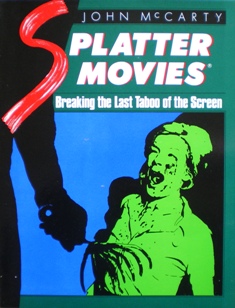 By JOHN McCARTY (St. Martin’s Press; 1984)
By JOHN McCARTY (St. Martin’s Press; 1984)
Apparently the most authoritative overview of the splatter movie phenomenon ever published—or so I’ve been told. After finally reading this book, however, I’m not too sure about that claim.
It’s a readable account, certainly, written by a man who knows his gory movies. John McCarty has also penned the two-volume SPLATTER MOVIE GUIDE, which fills in many of the gaps of this earlier book (and which I recommend in its place). Those gaps include essential splatter fests like THE FLESH EATERS and CANNIBAL HOLOCAUST, which are listed in the glossary of the final pages but appear nowhere else in the text. There’s also scant mention of foreign gore films like those of the Japanese “ero-guro” (erotic-grotesque) genre (although in all fairness, such films were little known to the Western world back in 1984).
What we do get is an account that argues gore is the cinema’s “last taboo.” All other filmic taboos, according to McCarthy, had been broken by 1920. I don’t entirely agree with that point, but will go along with McCarthy’s contention that gore took some time to come into its own onscreen.
McCarthy includes a brief overview of the Parisian Grand Guignol Theater, which kicked off the splatter movement back in 1899. Things apparently didn’t pick back up splatter-wise until England’s Hammer House of Horror movies of the fifties and sixties, followed by the low budget gorefests of H.G Lewis (BLOOD FEAST, TWO THOUSAND MANIACS, etc.). From there the unprecedented carnage of BONNIE AND CLYDE and Sam Peckinpah’s THE WILD BUNCH finally ushered gore into the mainstream, and the splatter movie was up and running.
That’s how John McCarty sees it. He ignores Nabuo Nakagawa’s 1960 grue fest JIGOKU (a.k.a. HELL), which predated H.G. Lewis’s films. The omission of the Roger Ebert-scripted BEYOND THE VALLEY OF THE DOLLS also galls, especially since McCarty concludes the book with an argument against Ebert and his late partner Gene Siskel’s early eighties crusade against gory movies (a mention or two of BEYOND THE VALLEY OF THE DOLLS would have given McCarty plenty of ammunition). And what’s with the comment that Italian splatter movies are “virtually interchangeable with those made in America, England, Spain or wherever”? I beg to differ!
There are also interviews with David Cronenberg, Tom Savini and TEXAS CHAINSAW MASSACRE actor Ed Neal. Far more comprehensive interviews with all three figures are available elsewhere, just as McCarty’s once groundbreaking insights on splatter movies have since been surpassed. This means that readers of this book are best advised to somehow transport themselves back in time to 1984, or simply find a more up-to-date resource.
